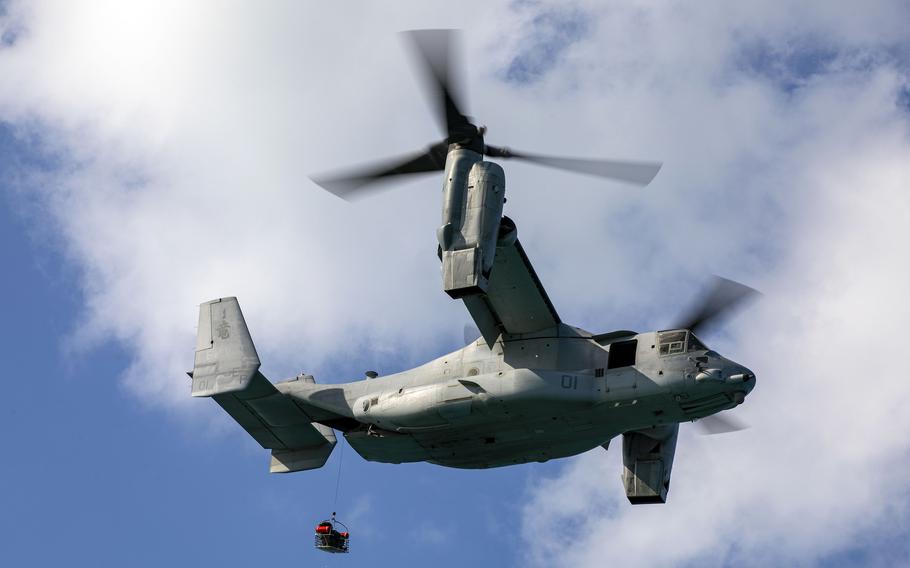
A Marine Corps MV-22B Osprey recovers a casualty from a simulated crash site off the coast of Okinawa, Jan. 22, 2025. (Samantha Rodriguez/U.S. Marine Corps)
CAMP FOSTER, Okinawa — The Marine Corps reduced its active fleet of MV-22 Ospreys on Okinawa last year, trimming the number from 24 to 20 aircraft as part of its evolving aviation strategy, according to Marine Corps spokesmen.
The cuts align with a broader reduction across the service’s tiltrotor squadrons, which have each gone from 12 to 10 operational Ospreys over the past two years, according to the 2025 Marine Corps Aviation Plan released Feb. 3.
The reductions include Medium Tiltrotor Squadrons 262 and 265, both based at Marine Corps Air Station Futenma, according to a chart released with the plan.
Maj. Joseph Butterfield, a spokesman for the 1st Marine Aircraft Wing, declined by email Thursday to specify when the cuts took place but noted the number of Ospreys on Okinawa could fluctuate depending on maintenance schedules and operational needs.
Squadron personnel levels have been adjusted accordingly, Butterfield said, without providing details.
The reductions are part of Force Design, the Marine Corps’ ongoing effort to transition toward a more agile, expeditionary force capable of countering China’s growing military presence in the Pacific.
The Project Eagle aviation strategy, outlined in Force Design, seeks to balance modernization efforts with budget constraints while maintaining combat readiness.
“Force Design realignment reflects a comprehensive evaluation of the structure and number of Marine Medium Tiltrotor Squadrons to enhance their overall effectiveness and responsiveness to meet Global Force Management (GFM) requirements,” Marine Corps spokesman Capt. Pedro Caballero said in an email Thursday.
The Marines first deployed Ospreys to Okinawa in 2012 to replace the aging CH-46 Sea Knight helicopters, adding a second squadron the following year. The Osprey, which takes off and lands like a helicopter but flies like a fixed-wing plane, plays a critical role in Marine Corps air mobility and amphibious operations.
Okinawa is not the only location affected. In fiscal 2024, Marine Corps Air Stations Kaneohe Bay, Hawaii, and New River, N.C., each saw reductions, following similar cuts in California in fiscal 2023.
Project Eagle introduces new operational concepts, such as distributed aviation operations, which spread out aircraft, command-and-control units, and support teams to make them harder to target, and decision-centric aviation operations, which incorporate artificial intelligence-driven decision-making.
The 2025 aviation plan highlights safety upgrades for the Osprey, including improvements to its proprotor gearbox using triple-melted steel components to reduce defects and a new drive system monitoring sensor designed to enhance safety and reliability through 2055.
The safety upgrades come in the wake of a Nov. 29, 2023, crash of a CV-22B Osprey off Japan’s Yakushima island that killed eight Air Force Special Operations Command airmen. In response, Naval Air Systems Command issued new guidelines on Dec. 20 regarding the Osprey’s gearbox components.
Despite the fleet reductions, the Marine Corps remains committed to the Osprey’s role in its Air-Ground Task Force, Caballero said.
“The Marine Corps is committed to maintaining the MV-22 Osprey’s position as the workhorse of the Marine Air-Ground Task Force well into the future,” he said.